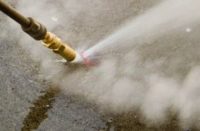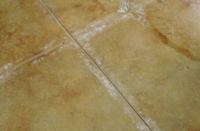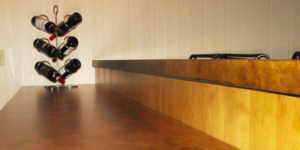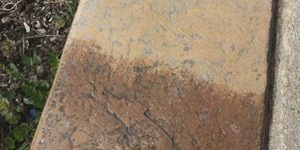
Is it possible to smell sealer months after application? Someone asked me this regarding a stained and sealed floor in a Colorado residence.
The homeowners wanted stained concrete in their new home. They selected a light brown acid stain and a solvent-based high-gloss acrylic sealer with multiple coats of a water-based finish as the sacrificial topcoat. The floors were stained and sealed the last week of October 2015. The weather had already turned cold, so the house was closed in, but the heat had not yet been turned on. Temperatures in the house were cold, but above product installation minimums.
Within two weeks of applying the stain and sealer (no wax yet), the cabinets in the bathrooms and kitchen were installed as was all the finish trim, tile and woodwork. Work in the house was complete by the end of December, at which time the heat was turned on.
According to the owners, the smell of solvent from the sealer had never really dissipated and when the heat was turned on, it really got bad. It eventually diminished but was always there. They aired the house out for days once they finally moved in at the end of January, but the sealer’s solvent odor remained.
Is it possible to have a solvent odor from the sealer still present after three months? My initial response was no way, but after researching the issue and getting more background it turns out the sealer was still giving off fumes, but only in specific places. Before we get back to where the odor is coming from, let’s take a quick look at why sealers smell the way they do.
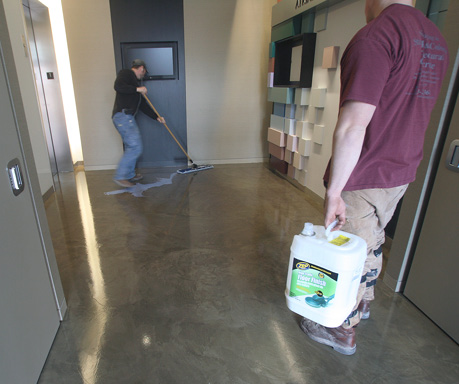
Chemistry lesson
In their most basic form, sealers are a combination of a solid and a liquid. When applied to the floor, the liquid evaporates and the solid remains and forms a protective film. It’s the evaporating liquid that’s the smelly culprit.
Depending on the type of liquid evaporating, the odor will vary greatly. One only needs to smell the difference between acetone and water to understand that point. The process by which sealers give up their liquid is called evaporation, and it’s the rate of evaporation that determines how long the smelly odors are going to stick around. There are a lot of factors that impact the evaporation rate including, but not limited to, air temperature, air movement, solvent type, air pressure and surroundings.
Now that we know the odor comes from the liquid evaporating as the sealer dries, we can start trying to figure out where or why the sealer is still drying months after application. The homeowners took initiative and ran tests to narrow down where the smell was coming from. In the end this proved to be important in determining the source of the odor and helping resolve the issue.
The homeowners’ take
The installer’s initial suggestion was to wax the floors with multiple coats to try and trap any remaining odors coming from the sealer. The response from the homeowners was, “While the waxing really made them [the floors] look even better, it did nothing for the smell.”
They then took matters into their own hands and spent weeks draping and airing out the house, all in the winter, to narrow down the source of the odor. Here’s an excerpt from an email explaining what they did:
“First, we aired out the house. Then we closed the doors to all the rooms and left for about two weeks. When we returned, the smell was noticeable in the main portion of the house. However, there was no smell in any of the rooms that had been closed off from the main portion of the house, other than a slight smell in the master bedroom/bath.
“Based on the above, we narrowed our focus to the main portion of the house. The only areas of the floor there that don’t have easy air circulation are under the lower cabinets in the kitchen, the cabinets between the living room and dining room, and the hall cabinets. We purchased plastic drop cloths and covered the lower kitchen cabinets and the cabinets between the living room and dining room as best we could.
“We again aired out the house, closed the doors to all the rooms and left for several days. When we returned, the smell was less noticeable in the main portion of the house and, again, there was no smell in any of the closed-off rooms. Once we started uncovering the cabinets, the smell increased.
“Our working hypothesis is that the stain/seal on the floors under the cabinets is still curing, and until there is some air circulation to those areas, the smell will never go away or not within a reasonable time frame (which should have been a week or two!). Our reasoning is based on the construction time line and the weather (at the time the cabinets were installed).”
Solving a mystery
So if the odor is coming from sealer that never completely dried and is slowly continuing to evaporate, why is there no smell from under the bathroom cabinets?
It turns out that when the tile was placed in the bathrooms the installer used a space heater and increased the air temperature significantly during the week after the sealer was applied and when the tile was being installed. The bathroom cabinets also have a much smaller footprint than the larger kitchen cabinets.
It turns out the homeowners’ hypothesis is the most plausible, and the first time I’d seen such a prolonged dry time for a sealer. No heat in the house meant cold concrete and cold air in the rooms. The cold temperatures slowed the evaporation of the sealer. Wintertime meant the house was closed up to retain the little heat there was, so no air movement.
Placing cabinets over a large section of the sealed floor reduced the air movement further, which also created a closed space concentrating the sealer odors. Those concentrated odors slowly escaped into the house. Anyone who has worked with solvent-based sealers knows that a little goes a long way in regard to odor, and just how irritating those odors can be.
Food for thought
The final solution was to find a way to air out the space under the cabinets in the kitchen. Borrowing a technique used by disaster restoration service companies when drying behind walls after floods, the toe kick was removed, 1-inch or so holes drilled every foot through the front cabinet bases and air was blown through the holes with floor fans. If that didn’t work, the cabinets would have to be removed to allow the sealer to dry and/or coat that area with a high-solids coating (not solvent based) to lock in any lingering odors.
The bigger concern is the real or perceived health issues created by the odors. “While we use the term ‘smell,’ the problem is more than just a nuisance,” the homeowners wrote. “If we cannot keep the house aired out enough (and we have the propane bills to prove how much ‘airing’ we have done this winter), then eye drops, cough drops, etc., all come into play, so we believe there are some health risks to this.”
I think this isn’t a case of negligence, but rather an unfortunate situation created by multiple unrelated factors. This article isn’t intended to lay blame, but rather to educate so we can all learn and possibly avoid a similar situation in the future.
Next time you seal an interior floor, consider the environment, temperature, air movement, and what the time line is for cabinets and furniture. I also suggest considering water-based sealers!
